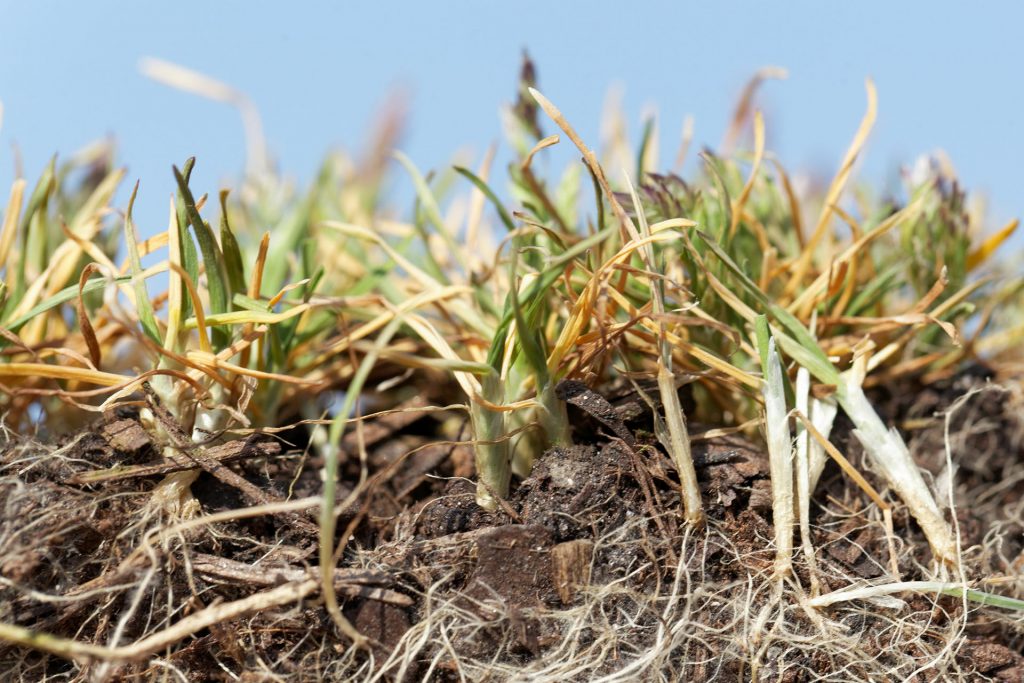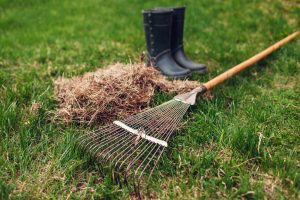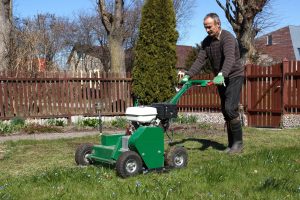
Have you ever looked at your lawn and noticed that it’s covered in a thick layer of brown material? If so, then you’ve got a case of thatch. Thatch is a common problem among lawns, and if it’s not dealt with, it can cause all sorts of problems for your grass.
Thatch can be a healthy, useful part of your lawn. And not every lawn will need dethatching. But when thatch becomes too thick, it can inhibit healthy turf growth. When that happens, it may be time to dethatch. Dethatching can be a DIY project. However, if the thatch is really thick, it may be necessary to hire professionals to avoid damaging the lawn too much. No matter what you do, a lawn with thick thatch will need some significant recovery efforts after dethatching.
In this blog post, we’ll discuss what dethatching is, why it’s important, and how to do it properly. We’ll also give you some tips on how to maintain your lawn after dethatching. So read on to learn more!
What is Thatch?
Thatch is a normal part of a healthy lawn. It is simply a layer of dead and living organic matter that accumulates on the surface of your lawn. It’s made up of things like dead grass clippings, roots, and other debris. Thatch can be either beneficial or harmful to your lawn, depending on its thickness.
A thin layer of thatch can actually help protect your grass from drought and disease. However, if the thatch layer gets too thick, it can start to choke out your grass, preventing it from getting the air and nutrients it needs to thrive.
If you dig a spade into your lawn and pull up a cross-section, you will see where the thatch is. Thatch is a (hopefully thin) layer of dead and living organic matter that builds up between the soil and the green part of your turf plant. Contrary to popular belief, grass clippings do not contribute to thatch. They are mostly water and decompose quickly. But some materials decompose less quickly, and when the organic material starts to build up more quickly than it can decompose, it becomes thatch.
In a healthy lawn, thatch should be less than one-half-inch thick. This thin layer of thatch helps your lawn retain water, much like a layer of mulch. It can also protect the soil beneath from large fluctuations in temperature, which is beneficial for your turf roots. As long as the thatch remains thin, water, nutrients, and fertilizer can penetrate and reach the plant roots. However, when the thatch becomes too thick, it can begin to pose a problem.
Thick Thatch
Thick thatch, an inch thick or more, can smother your turf. It prevents water, air, and nutrients from reaching the soil below. And it can hold water from irrigation. When the thatch becomes saturated, the water can suffocate plant roots. The moisture also provides a welcoming environment for fungus and other diseases.
Worst of all, if your thatch grows too thick, plant roots may not be able to penetrate, and the roots will grow entirely within the thatch layer. This leaves them vulnerable to both drought and overwatering or any other form of stress. Once the thatch has grown so thick that the turf is rooted in the thatch, it becomes very difficult to remove it without damaging the turf. At a certain point, your only option is to dethatch your lawn. This will tear up the thatch and the plants growing in it. Afterward, you may have to overseed or lay new turf.
Why Does Thatch Develop?
There are a few reasons why thatch can build up on your lawn. One reason is simply because of how you care for your lawn. If you leave grass clippings on your lawn after mowing, or if you don’t rake up leaves in the fall, that debris will decompose and contribute to thatch. Another reason that thatch can develop is due to compaction. Compacted soil doesn’t allow water, air, and nutrients to penetrate the root zone of your grass, which can lead to an accumulation of thatch.
A thin layer of thatch is healthy for your lawn. But a thick layer can cause significant damage. Normally, organic matter should decompose at about the same rate that it builds up. This leaves your lawn in balance and prevents a thick layer of thatch. But some conditions may throw off that balance.
One factor in thatch growth is the health and condition of your soil. In a healthy lawn, microbes in the soil help break down organic matter before it can pile up into a thick thatch layer. But when the soil is dead or sterile, there aren’t enough microbes to break down the growing layer of organic matter, and the thatch layer thickens. Poor pH balance can contribute to poor soil health, which leads to thatch buildup. If the soil pH is too low, it may be necessary to add lime. Soil that is too acidic is a poor environment for microbes. Soil can also be too alkaline, with a high pH. The ideal pH for turf growth is about 6.8, or slightly acidic. Anything higher or lower than that will lead to a less healthy lawn.
Cultural practices can also contribute to thatch growth. Over-fertilizing with a high-nitrogen fertilizer and overwatering can cause the grass to grow too quickly. As the grass grows faster than the microbes can break down the thatch layer, it thickens.
Poorly laid sod can also lead to thatch. If new sod is not watered deeply, the roots won’t grow into the soil, leading to early thatch buildup. If sod is put down over clayey or compacted soil, the roots may have a hard time penetrating the soil, with similar results.
Some varieties of turf are more prone to thatch than others. Quick-growing and spreading turf, like Kentucky bluegrass, Bermudagrass, and creeping fescues, are more prone to thick thatch layers. Grasses that grow more slowly and clump, like tall fescue or perennial ryegrass, are far less likely to need dethatching.
What is Dethatching?
When thatch has become too thick, you may notice that the grass is thin and unhealthy looking. If there is a drought and the grass is rooted in the thatch instead of the soil, the grass may even go dormant. If the thatch is holding water, you may also see signs of disease and root rot. When this happens, the only solution is to dethatch your lawn.
Dethatching is the process of removing thatch from your lawn. It’s a good idea to dethatch your lawn every few years or whenever the thatch layer gets too thick. Dethatching can be done with a machine called a dethatcher or by hand using a garden rake.
Dethatching Tools
Three tools may be used for dethatching.
- Manual dethatching rakes are effective for relatively thin thatch and small lawns. A dethatching rake is heavy, with short tines and curved blades that sink into the thatch layer and pull it up as you rake.
- Power dethatching rakes are similar to a mower. They feature rotating tines like the tines on a manual rake. A power rake is only good on thin to moderate thatch and only on lawns that can withstand intense raking.
- Vertical mowers are suitable for thick thatch on lawns that will need significant renovation. A vertical mower, also called a verti-cutter, has vertical rotating blades that dig into the soil and pull up the thatch. The blades are adjustable so that you can choose how much thatch to dig up with each pass.
When is the Best Time for Dethatching?
The best time to dethatch your lawn is in the spring before the grass starts to grow too much. This will allow your grass to recover from the dethatching process and fill in any bare spots. You don’t necessarily need to dethatch every year, but it’s a good idea to do it every few years or as needed.
Why Is Dethatching Vital to Lawn Health?
Dethatching is important because it helps prevent problems like compaction, thatch build-up, and unhealthy grass. By removing thatch, you’re allowing air, water, and nutrients to reach the root zone of your grass. This helps promote a healthy lawn.
A thick layer of thatch can prevent water, air, and nutrients from reaching the roots of your grass. This can lead to a host of problems, including drought stress, disease, and pests. Dethatching also helps to improve the drainage of your lawn and reduce compaction.

You can dethatch by hand or with tools.
How to Dethatch Your Lawn
There are a few different ways to dethatch your lawn. You can use a dethatcher, or you can dethatch by hand.
If you’re using a dethatcher, be sure to read the instructions carefully before operating the machine. Start by mowing your lawn short, then rake up any clippings or leaves. Next, wet your lawn thoroughly with a hose or sprinkler. This will help the dethatcher work more effectively. Then, simply run the dethatcher over your lawn according to the manufacturer’s instructions.
If you’re dethatching by hand, start by mowing your lawn short and raking up any debris. Then, use a garden rake to loosen the thatch from the soil surface. Be sure to rake in different directions to get all of the thatch out. Once you’ve removed all of the thatch, rake it up and remove it from your lawn.
What Comes Next? After Dethatching Your Lawn
Dethatching can be incredibly stressful on a lawn and may pull up large amounts of grass along with the thatch. If your lawn is dying because of thick thatch, dethatching may be your only option. However, you will need to repair your lawn after a significant dethatching process. This may mean overseeding or even laying down new sod.
Once you’ve repaired your lawn, it is time to develop a plan to avoid thatch buildup in the future. Thatch is often exacerbated by compact soil, so an annual aerating plan is a good place to start. Keeping soil loose and giving your turf roots access to air, water, and nutrients will help their roots grow deep into the soil.
It is also a good idea to test your soil every three to four years to determine its pH and calibrate how much nitrogen fertilizer you need to give your lawn. By maintaining a healthy pH, you provide the microbes in the soil the best chance at keeping down thatch. And avoiding over-fertilizing will also help prevent thatch buildup.
Finally, adding hummus or other high-quality organic material to your lawn is a great way to introduce more of the helpful microbes that break down thatch and keep it from getting out of hand.

Regular aerating helps keep your lawn healthy.
Next Steps
After dethatching your lawn, it’s important to take care of it properly to ensure that the thatch doesn’t come back. Here are a few tips:
– Aerate your lawn regularly to prevent compaction.
– Mow your grass at the proper height to prevent scalping.
– Use a mulching mower to chop up grass clippings and leaves, which will help prevent thatch build-up.
– Rake up leaves in the fall to prevent them from decomposing and contributing to thatch.
– Water deeply and less frequently to promote deep root growth.
Takeaways
Dethatching is the process of removing thatch from your lawn. Thatch is a layer of dead and living organic matter that can either be beneficial or harmful to your lawn. Dethatching is important because it helps prevent problems like compaction, thatch build-up, and unhealthy grass.
The best time to dethatch your lawn is in the spring before the grass starts to grow too much.
After dethatching your lawn, take care of it properly by regularly aerating, mowing at the proper height, using a mulching mower, raking up leaves in the fall, and watering deeply and less frequently. By following these tips, your lawn will stay healthy, lush, and beautiful for your yearlong enjoyment.
